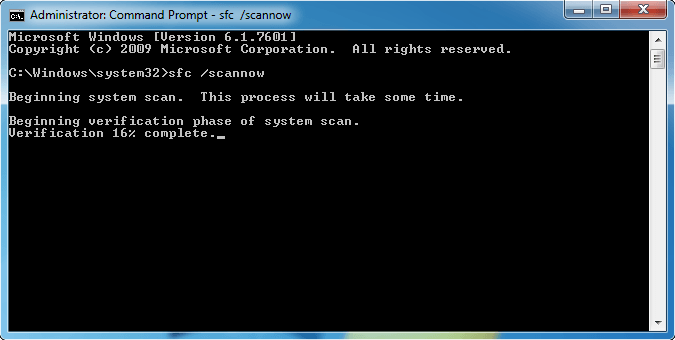Types Of Files Protected By System File Checker
Sfc /scannow will inspect all of the important Windows files on your computer, including Windows DLL files. If System File Checker finds an issue with any of these protected files, it will replace it. System file check is a utility built into the Operating System that will check for system file corruption The sfc /scannow command (System File Check) scans the integrity of all protected operating system files and replaces incorrect, corrupted, changed, or damaged versions with the correct versions where possible.
About SFCList: SFCList is the utility to enumerate files protected by SFC mechanism.Windows has introduced SFC technology (System File Checker) to protect core system files from being accidently or intentionally modified by third party programs. This tip will discuss repairing the system with System File Checker (SFC). This is one of the numerous command-line system tools that come on all current versions of Windows. It will scan all protected system files and replace incorrect or damaged versions with copies from a backup cache or from an installation disk or folder. 2 Tools to List Files Protected by System File Checker (SFC) You can either use the -l switch to list all system protected files or the -p to verify if the specified file is protected. The MD5 hash is also included for the listed files. The -p switch is actually nothing special because you can achieve the same thing from sfc.exe tool using the /verifyfile command. The System File Checker is a little-known, simple-to-run command-line program. It validates that Window's operating files are undamaged. In order to prevent malware from replacing critical system components with compromised copies, Windows works very hard to maintain the integrity of the system. System File Checker. In Windows 10/8/7/Vista, the System File Checker is integrated with Windows Resource Protection, which protects registry keys and folders as well as critical system files. If any changes are detected to a protected system file, the modified file is restored from a cached copy located in the Windows folder itself.
Is your Windows 10 PC is constantly crashing? Is your Windows 10 PC hangs a lot? Are you getting file missing or corrupted error in Windows 10? Run the built-in System File Checker tool to address these issues.
System File Checker is a command line utility in Windows 10 that allows users to scan for missing and corrupted system files and repair them. The tool can be run either via Command Prompt or PowerShell.
The System File Checker tool is helpful when your PC is not working as expected or showing file missing or corrupted errors.
Run System File Checker in Windows 10
Complete the given below directions to run System File Checker tool in Windows 10.
Step 1:Open Command Prompt as an administrator. You can do that by typing CMD in the Start/taskbar search field, right-clicking on Command Prompt entry and then clicking Run as administrator option.
Click Yes button when you get the User Account Control prompt.
Step 2: At the Command Prompt window, you need to execute the following DISM tool first before running the System File Checker tool.
Types Of Files Protected By System File Checker
DISM.exe /Online /Cleanup-image /Restorehealth

The above command uses Windows Update to download files that are required to fix file corruptions.
If you have disabled Windows Update or Windows Update is not working for some reason, please connect Windows 10 bootable media to your PC and then run the following command instead of the above one. If you don’t have the bootable media, download Windows 10 latest version ISO from Microsoft, mount the ISO file, and then execute the following command.
DISM.exe /Online /Cleanup-Image /RestoreHealth /Source:C:RepairSourceWindows /LimitAccess
Types Of Files Protected By System File Checker Pdf
In the above command, replace “C:RepairSourceWindows” with the location of the resource source.
Step 3: Next, type the following command and then press Enter key.
sfc /scannow
The above command scans all protected system files and replaces corrupt files with a cached copy of the file present in a compressed folder located at System32dllcache.
The above command might take some time to process. So, be patient.
Step 4: Once the system file checker completes its job, you will see one of the following messages:
# Windows Resource Protection did not find any integrity violations
If you land on a space with the word LIFE printed on it, take a LIFE tile and place it in your pile. • Throughout the game there are spaces known as 'Career' spaces. Mb game of life rules 1984.
The above message indicates that there are no missing or corrupted system files on your PC.
# Windows Resource Protection could not perform the requested operation
If you get this message, you might need to run the System File Checker in Safe mode again. We recommend running System File Checker once again in normal mode before trying that in safe mode.
# Windows Resource Protection found corrupt files and successfully repaired them.
You will get the above message when System File Checker detected corrupt or missing files and managed to repair them without any issues.
# Windows Resource Protection found corrupt files but was unable to fix some of them.
If you get this message, you can either try running the System File Checker tool again or view the log file (%WinDir%LogsCBSCBS.log) and then manually replace corrupted files.

Should the System File Checker fail to address the issue, you can try restoring Windows 10 to a previous date or repair Windows 10 install without losing apps and your data.